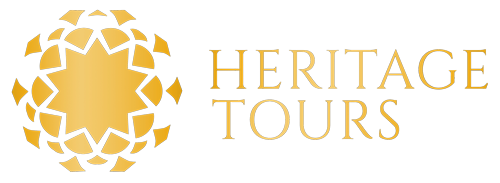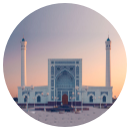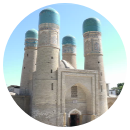Islamic Guide To Uzbekistan
Country
Uzbekistan
Cities
Tashkent – Samarkand - Bukhara - Khiva
Currency
Uzbekistani So'm
Uzbekistan is known for its mosques, mausoleums and other sites linked to the Silk Road, the ancient trade route between China and the Mediterranean. The main cities include Tashkent, Samarkand, Bukhara and Khiva all containing landmarks of Islamic architecture, breath taking scenery, a richness of culture and heritage.
TASHKENT
Is the capital city of Uzbekistan and is known for its museums and its mix of modern and Soviet-era architecture. The original mushaff with the blood stains of Uthman bin Affan (RA) when he was made a shaheed can be viewed. The Amir Timur Museum houses manuscripts, weapons and other relics from the Timurid dynasty.
SAMARKAND
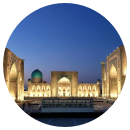
The ancient trade route the “Silk Road” links China to the Mediterranean and is known for its Masjids and Mausoleums. Prominent landmarks include the Imam Bukhari Mausoleum (the grave of Imam Bukhari), The Registan (dating to the 15th & 17th centuries), and Gur-e-Amir, the tomb of Timur (founder of the Timurid Empire).
BUKHARA
Bukhara is an ancient city and was a prominent stop on the Silk Road trade route between the East and the West, and a major centre for Islamic theology and culture. It still contains hundreds of well-preserved mosques, madrassas, bazaars and caravanserais, dating largely from the 9th to the 17th centuries.
KHIVA
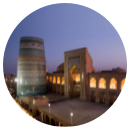
Khiva is a very ancient city and in the 10th century Khiva was as a major trading centre on the Silk Road. All the caravans had a stop here on their way to China and back and from dawn to dusk, there was an endless stream of moving string of camels merchandise and traders that passed through this historical city.
STEP BY STEP GUIDE TO UZBEKISTAN
- Heritage Tours offers 2 tours a year accompanied with renowned Islamic Scholars which take place in April and September.
- To enter Uzbekistan, a passport valid for three months beyond the date of arrival is required by all nationals referred to in the chart above. One blank page is needed for the visa.
- As of 01 February 2019, nationals from 45 countries are eligible for visa-free travel for 30 days from the date of entry into Uzbekistan. These countries are: Andorra, Argentina, Australia, Austria, Belgium, Bosnia and Herzegovina, Brazil, Brunei, Bulgaria, Canada, Chile, Croatia, Cyprus, Czech Republic, Denmark, Estonia, Finland, Greece, Hungary, Iceland, Ireland, Italy, Latvia, Liechtenstein, Lithuania, Luxembourg, Malta, Monaco, Mongolia, Montenegro, Netherlands, New Zealand, Norway, Poland, Portugal, Romania, San Marino, Serbia, Slovakia, Slovenia, Spain, Sweden, Switzerland, the United Kingdom, and the Vatican.
- To apply or check status of your visa eligibility visit www.e-visa.gov.uz
- Hygiene is generally good, streets are clean, sanitizing is common and the Uzbek people are very conscious of cleanliness.
- It is recommended to bring some motion sickness pills from home for the journeys.
- A suggestion on some vaccinations to have for your journey include:
- Hepatitis A / Diphtheria / Tetanus
- Uzbekistan is one of only two double-landlocked countries in the world (the other being Liechtenstein) so the most common ways of getting to Uzbekistan are by air.
- The main international airport is in Tashkent (TAS).
- The national airline is Uzbekistan Airways www.uzairways.com which offers direct flights from major destinations. There are also plenty of indirect fight options with carriers such as Emirates emirates.com and Turkish Airlines www.turkishairlines.com
- Customs forms are required to be completed on arrival for you to declare any currency you are either bringing into, or taking out, along with the amount.
- There are no departure taxes.
- Uzbek Som is the official currency but US dollars, Euros & GBP are also widely accepted. AUD are not accepted.
- Credit cards MasterCard & Visa are accepted in some of the major hotels in and a few top restaurants in the capital.
- ATMs can be found in all the main cities.
- Travellers cheques have a very limited acceptance.
- Currency exchanges are located around the main cities and the rates are mainly consistent with the central bank.
- Always take your passport with you as proof of ID when exchanging money.
- WIFI services generally offer poor connectivity in hotels.
- Sim cards can be purchased at the airport on arrival or at phone shops and you will require your passport as proof of ID.
- Uzbek and Russian are the main languages spoken in Uzbekistan, basic English is understood at most tourist attractions.
- Muslims constitute some 90% of Uzbekistan’s population.
- Predominantly Sunni Muslim, with Shia (15%), Russian Orthodox and small Jewish minority.
- Uzbekistan is a Muslim country, albeit a fairly liberal one where women often wear jeans and skirts in the cities.
- However, for visitors it’s best to cover up out of respect to the local culture and to avoid unwanted attention in all areas, but especially in the conservative Ferghana Valley.
- In general, lipioshka (bread) should never be laid upside down and should never be put on the ground, even if it is in a bag.
- It is normal to remove shoes but not socks when entering someone’s house or sitting down.
- Hospitality is genuine in Uzbekistan and many follow the saying: “The visitor is dearer than your father.”
- While crime is rare, it’s wise to avoid ostentatious displays of wealth (e.g. jewellery) in public places.
- Homosexuality is illegal.
- Around a third of the country’s population is aged under 14.
- Uzbekistan has an extreme continental climate. It is generally warmest in the south and coldest in the north.
- Temperatures in December average -8°C (18°F) in the north and 0°C (32°F) in the south. During the summer months, temperatures can climb to 45°C (113°F) and above and humidity is low.
- The best time to visit is during the spring and autumn, with April and September being the absolute optimum month.
- In the winter it can be bitterly cold so bring layers.
- In the summer, it gets very hot so loose, breathable cottons are best.
- Uzbekistan is one of the safest countries you can visit.
- It boasts a very low crime rate and doesn’t have the safety concerns (such as pickpocketing) that you may find in many European cities.
- Tashkent being the capital of Uzbekistan with the largest international airport in the country, you are most likely to fly into and out of Tashkent. Wandering around the city, you’ll find part of it cluttered with modern buildings; another part adorned with Soviet-style architecture, and yet another part that’s more traditionally Uzbek with mud-walled houses, crowded bazaars, and traditionally clad farmers hard at work.
- Places to visit:
- Metro stations–Tashkents’ metro stations were built in the former USSR era and are amongst the most ornate and well-decorated in the world.
- Minor Mosque– built in 2013, it’s one of the newer monuments of the city and is covered in white marbles.
- Chorsu Bazaar– being the biggest farmers market in town, it’s the perfect place to find colourful mountains of spices, sweets, souvenirs, and the freshest fruits around.
- Hazrat Imam Complex– a religious centre with a madrasah, mausoleum, and Islamic Institute, where future preachers are taught.
- Amir Timur Museum & Square– a museum about the Timurid empire sitting inside a square that also houses the very interesting architecture of Uzbekistan Hotel.
- Museum of Islamic Manuscripts – The location of Usman ibn Affan (RA) muskhaf from the 7th century.
- Independence Square – Independence Square is located in the centre of Tashkent city. It is a favourite resting place for the Tashkent residents. The fact that the most beautiful fountains of the city are located in the square contributed considerably to it.
- Alisher Navoi Park – Is one of Uzbekistan’s largest urban parks. It was founded in 1932 and was constructed on the site of the quarry of an old brick factory by volunteers. Currently, it bears the name of great medieval enlightener Alisher Navoi. The area of the park’s land is 65 ha, while its lake and network of canals make up a total of 9 hectares.
- Samarkand was founded in the 7th century B.C. and is one of the oldest cities in Central Asia. Its geographic location in the centre of major trade routes attracted a lot of travellers and invaders. It has been captured by both Alexander the Great in 329 BC and Genghis Khan in 1220. In the 14th century, it became the capital of the Timurid Empire. Through the course of its history, it has been ruled by Persians, Greeks, Turks, Mongols, Chinese, and Russians. Half a dozen religions have found a home here. Today, it is the second largest city in Uzbekistan and part of the UNESCO World Heritage, listed as ‘Samarkand — Crossroads of Cultures.’
- Places to visit:
- Imam Bukhari Mausoleum – It is final resting place of one of the renowned preachers of Islam, Imam Al Bukhari.
- Registan– the pearl of the city; a square with three of the world’s oldest madrasas, worth visiting both at day and at night.
- Gur-e-Amir– this stunning piece of architecture was the model for the Taj Mahal.
- Shah-i-Zinda – an avenue of mausoleums that showcase some of the richest tile work in the Muslim world.
- Bibi-Khanym Mosque – the jewel of the Timurid Empire, this was once one of the biggest mosques in the Islamic world.
- The Siob Bazaar – the city’s vibrant main market is a great place to get a taste of local food and treats – be sure to try halva (a sweet that resembles fudge).
- Ulugh Beg Observatory– it showcases some of the world’s most advanced astronomical studies led by a Timurid ruler.
- Bukhara is a city more than 2,000 years old. Its historic centre has been preserved very well for the last two centuries. It therefore gives a great glimpse into a medieval Central Asian Muslim city filled with ancient religious architecture.
- Places to visit:
- Kalyan Minaret– Genghis Khan was so impressed by this tower that back in the 13th century, that he ordered it to be spared while his troops destroyed the rest of the city.
- Kalyan Mosque – this mosque, with a spectacular courtyard, is right next to Kalon Minaret.
- Ark Fortress – Bukhara’s oldest structure was the residence of its emirs for centuries.
- Chor Minor – the gatehouse of a long-gone madrasah built in 1807, it has four minarets that each represent a different religion.
- Abdulaziz-Khan Madrasah– built in 1652, its intricate, colourful tiles are truly impressive.
- Bolo Hauz Mosque– known as the 40 Pillar Mosque, its ceiling is held by 20 wooden pillars that reflect elegantly in the pond in front of it.
- Lyabi-Hauz Complex– a peaceful yet lively 17th century trading square with music playing in the evenings, and a pond with restaurants around it.
- Taki-Telpak Furushon– a colourful domed bazaar with lots of interesting souvenir shops.
- Amir Olimkhon Madrassah (14c) – The madrasah was built by the last emir of Bukhara, Said Mir Amir Alimkhan from the Mangyt dynasty
- Khiva is out of all the Silk Road gems in Central Asia, the city of Khiva is perhaps the most intact, remote, and preserved of them all. This medieval town is essentially an open air museum. It has a fortress surrounding its inner city, which is home to dozens of ancient madrasas, mosques, minarets, and clay-coloured houses.
- Places to visit:
- Itchan Kala– the inner town of Khiva, in which most of the city’s attractions reside. It gets crowded with tourists during the day, but walking around at dawn or dusk makes for a very peaceful and unique experience.
- Tash Hauli– a palace inside the Itchan Kala with extravagant interior decorations, blue ceramic tiles, more than 150 rooms, and 9 courtyards.
- Juma Mosque– this unique mosque has 218 wooden columns supporting its roof.
- Kuhna Ark – a fortress that used to be the residence of Khiva’s rulers.
- Watchtower – accessible through the Kuhna Ark, this is a really good spot to watch sunset with a gorgeous view of the city.
- Isfandiyar Palace– a 10-minute walk outside the west gate, it’s home to gold-embroidered ceilings and lavish chandeliers.
- Kalta Minor Minaret– a turquoise-tiled minaret begun in 1851 by Mohammed Amin Khan, who aspired for it to be 80m tall. Unfortunately, he dropped dead in 1855, leaving the structure unfinished at 29m, but still looking mesmerizing.
- Islom Hoja Minaret– standing 57m tall, it has the resemblance of a lighthouse, and you can climb it for fine views over the city.
- By Train – There are multiple daily trains connecting Samarkand, Bukhara, and Tashkent. Many of them are high-speed e.g. Afrosiyob, meaning a journey between Samarkand and Tashkent or Samarkand and Bukhara would only take 1-2 hours.
- By Air – There are airports in Tashkent, Samarkand, Bukhara, and Urgench (which is about a 30-minute drive from Khiva). Frequency of flights is however limited but is the best option to get to Khiva.
- By Taxi – Within Uzbekistan cities, taxis are very cheap. They usually cost $1.25 for a 10-15 minute ride. You mainly need taxis when going to the train station/airport, or when visiting a few remote attractions away from the historic centres.
- There is a range of 5 star to cosy boutique hotels that you can experience in Uzbekistan but wifi connectivity isn’t the best.
- The Uzbek cuisine is one of the most exquisite and flavourful you will ever find and it will leave you craving for more even after leaving the country. Some must-try national dishes are: plov, shurpa, lagman, manti, somsa, naan bread, shashlik, kazan kabob, and shivit oshi.
- Vegetarian options are available but limited in selection.
Enquire
1
Step 1
keyboard_arrow_leftPrevious
Nextkeyboard_arrow_right
